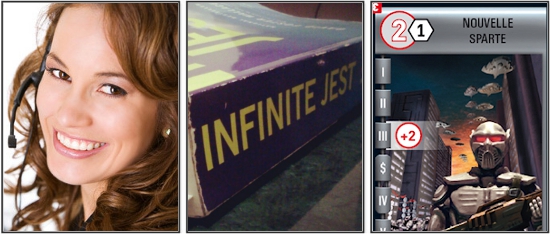Editors’ Picks 5/11: Race For The Infinite Playstations
This week in Editors’ Picks: Sony’s Customer Service is fantastic, but you would be too if you got this much practice! How to let David Foster Wallace laugh at you from beyond the grave, and get ready to race for the galaxy because let’s face it; you don’t stand a chance at winning any kind of physical race.
James’ pick: Sony PlayStation Customer Support
I’m calling from the United States, and everyone who answers not only speaks English, but has an American accent. (I’m not sure if the accent changes based on the number you call, but that’d make sense and be quite smart.) Everyone also either seems like a gamer — they’re hip with the jive, if you will — or at the very least knows how to fake knowing about games very, very well. When I called the time before last for break #3, they asked what games I managed to play before it broke. I told the lady on the phone that I played Skyrim and Child of Eden. She immediately recognized Child of Eden, easily the lesser known and buzzed about of the pair, and we discussed the merits of the game as she was typing whatever it is customer support people type into their computer when you’re done complaining. This time, I was put on the phone with someone from the actual technical department, seeing as how this was the fourth time my “fixed” PS3 broke. He was extremely helpful, and seemed genuinely interested in my story. On top of that, he told me that I should not only be madder than I actually sounded (when is a customer support person ever that honest?), but that I shouldn’t give up on the technical department just yet, as he wouldn’t — and I shouldn’t — call it quits and give up my backwards compatible PS3, a feature Sony has been systematically eradicating for a while.
Eric’s pick: Infinite Jest
1. Mandatory footnotes I might add.a
A. Kind of like this footnote is mandatory, although DFW’s footnotes are mandatory in that you have to read them whereas these footnotes are mandatory because you basically have to make footnote jokes when talking about Infinite Jest.
Max’s pick: A Militaristic Strategy for Race for the Galaxy
The card-based game of interplanetary conquest and commerce has long been a staple of Geekosystem gaming, but I have often struggled with how to win the game while focusing on military cards. Please note, in an effort to make this as brief as possible, I will assume that all of you are already extremely familar with the game. The result will surely be impenetrable for most of you, but I kinda like that idea.
As far as I can tell, the basic military strategy is to use the +5 Explore as often as possible, building up your tableau to 12 cards and ending the game before the players pursuing a production path can run their economies and make mad points. This strategy has two major drawbacks. The first is that there are only two end-game cards that reward using a military strategy, which means that you’re not too damn likely to find them. Especially if someone else is using the same, or a similar strategy.
The second is that you’re essentially throwing away two (well, three technically) of the six possible phases — produce and consume — that other players will be throwing down. Those are lost turns, and lost turns don’t help a speed-based strategy.
My moment of clarity came when I realized that the far more common blue (Novelty Goods) and brown (Rare Elements) worlds have only a few military worlds, while the rarer and more valuable yellow (Alien) and green (Genetic) worlds have a higher proportion available for conquest. What’s more, these high-yield cards open other opportunities from bonus points from cards like Alien Science Academy, and generally have higher victory points associated with them. If you need more convincing, consider that the goods from these worlds yield more cards during the consume-trade phase — giving you the opportunity to put down planets and still search the deck.
It seems to me that the most effective military strategy focuses on exploration and settling, but makes time for production and even some consume-trading on green and yellow worlds. A pure military strategy overly relies on luck, while a mixed strategy focusing on those two areas of production tilts the scales in your favor.
- Awesomenauts, WTF podcast, and Adventure Time
- Poutine, Fez, and Blunderbuss
- Pocket, Dustforce, and Locked Down
Have a tip we should know? tips@themarysue.com
